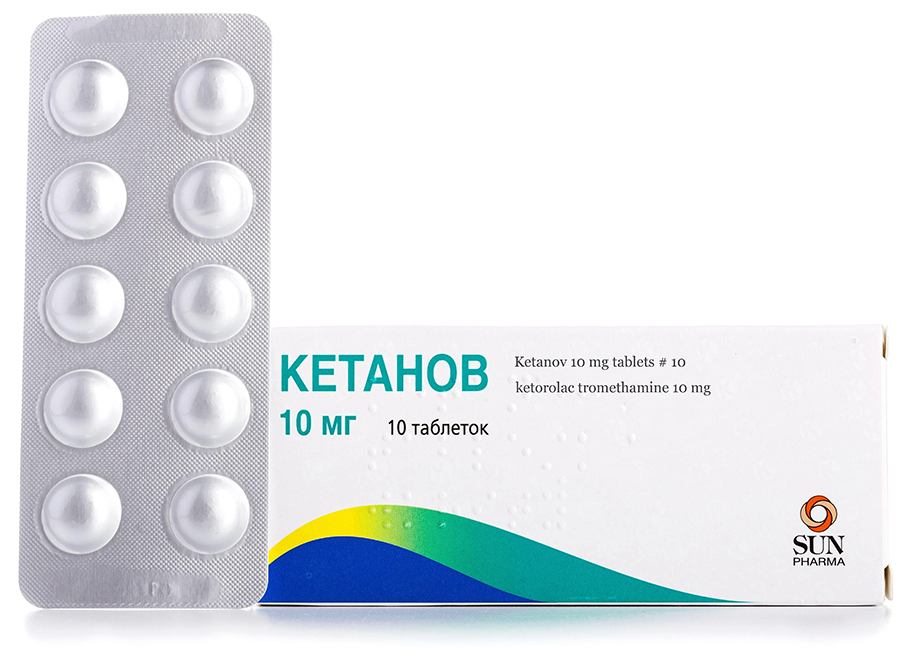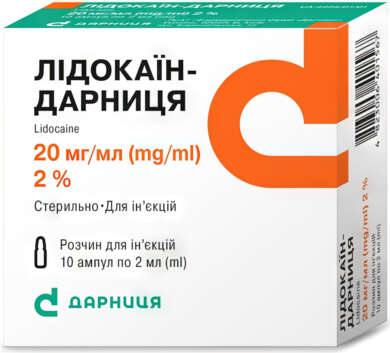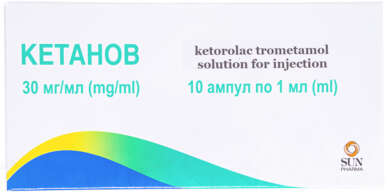Description
Buy Ketanov 10 mg tablets # 10
Description of Ketanov:
Ketanov. Pain reliever. Non-narcotic analgesic. Shows anti-inflammatory and weak antipyretic activity. Ketorolac inhibits the synthesis of prostaglandins and is an analgesic of peripheral action. Ketorolac has no known effect on opiate receptors. After the use of ketorolac tromethamine in controlled clinical trials, no phenomena were observed that would indicate respiratory depression. Ketorolac tromethamine does not cause pupillary constriction.
Ingredients:
Active substance: ketorolac tromethamine 10 mg;
Excipients: microcrystalline cellulose, corn starch, anhydrous colloidal silicon dioxide, magnesium stearate, hydroxypropyl methylcellulose, macrogol 400, talc, titanium dioxide (E 171).
Pharmacodynamics of Ketanov 10 mg tablets # 10:
Ketanov. Pain reliever. Non-narcotic analgesic. Shows anti-inflammatory and weak antipyretic activity. Ketorolac inhibits the synthesis of prostaglandins and is an analgesic of peripheral action. Ketorolac has no known effect on opiate receptors. After the use of ketorolac tromethamine in controlled clinical trials, no phenomena were observed that would indicate respiratory depression. Ketorolac tromethamine does not cause pupillary constriction.
Pharmacokinetics of Ketanov 10 mg tablets # 10:
Ketorolac tromethamine is rapidly and completely absorbed after oral administration, with a peak plasma concentration of 0.87 mg/kg 45 minutes after a single 10 mg dose. In healthy volunteers, the terminal plasma half-life averages 5.4 hours. In the elderly (mean age 72 years) it is 6.2 hours. More than 99% of ketorolac in plasma is protein bound. Ketorolac is very difficult to penetrate into the brain tissue. A small amount can be found in breast milk. In a healthy person, less than 50% of the administered dose is metabolized. Important metabolites are the glucuronide conjugate and 4-hydroxy-ketorolac, the metabolites of which are already pharmacologically inactive. In humans, after single or multiple dose administration, the pharmacokinetics of ketorolac is linear. Stationary plasma levels are reached after 1 day when applied 4 times a day. With long-term dosage, no changes were observed. In healthy volunteers, the terminal plasma half-life is 4-6 hours (average 5.4 hours). The plasma half-life increases in patients with renal insufficiency and in elderly patients. In the elderly (mean age 72 years) it is 6.2 hours. After the introduction of a single dose, the volume of distribution is 0.25 l / kg, the half-life is 5 hours, and the clearance is 0.55 ml / min / kg. The main route of excretion of ketorolac and its metabolites (conjugates and p-hydroxymetabolites) is urine (90%), and the rest is excreted with feces. Food rich in fat and difficult to digest reduces the rate of absorption, but not the volume, while antacids do not affect the absorption of ketorolac.
Indications for use of Ketanov 10 mg tablets # 10:
Short-term treatment of pain of moderate intensity, including postoperative pain.
The maximum duration of treatment is 5 days.
Contraindications of Ketanov 10 mg tablets # 10:
- Hypersensitivity to ketorolac or other NSAIDs or other components of the drug;
- Manifestations of hypersensitivity, such as bronchial asthma, rhinitis, angioedema or a history of urticaria caused by the use of acetylsalicylic acid or other NSAIDs (if possible, severe anaphylactic reactions);
- Gastrointestinal bleeding or perforation is active or in history, which is associated with the use of NSAIDs;
- Active recurrent peptic ulcer / gastrointestinal bleeding (two or more episodes) in the acute stage or in history;
- Do not use as an analgesic before and during surgery and after manipulations on the coronary vessels due to inhibition of platelet aggregation, which can cause bleeding;
- Suspected or confirmed cerebrovascular bleeding, hemorrhagic diathesis, including clotting disorders and high risk of bleeding, as well as in the postoperative period, if there is a high risk of bleeding or incomplete hemostasis;
- Complete or partial nasal polyp syndrome, Quincke’s edema or bronchospasm;
- Simultaneous treatment with other non-steroidal anti-inflammatory drugs (NSAIDs) (including selective cyclooxygenase inhibitors), acetylsalicylic acid, warfarin, oxpentoxifylline, probenecid or lithium salts, anticoagulants, including low doses of heparin (2500-5000 units every 12 hours);
- Violation of hematopoiesis of unknown etiology;
- Severe heart failure;
- Bronchial asthma in history;
- Hepatic or moderate and severe renal insufficiency (serum creatinine level more than 160 µmol/l);
- The risk of kidney failure as a result of a decrease in fluid volume;
- Hypovolemia, dehydration;
- The drug is contraindicated during pregnancy, during contractions and childbirth and while breastfeeding;
- Do not apply to children and adolescents under the age of 16 years.
Interactions:
Ketorolac readily binds to plasma proteins (mean value 99.2%), and the degree of binding depends on the concentration.
Do not use simultaneously with Ketorolac.
Ketorolac should not be used with other NSAIDs, including selective cyclooxygenase-2 inhibitors, including patients receiving acetylsalicylic acid, due to the risk of severe adverse reactions.
Ketorolac inhibits platelet aggregation, reduces the concentration of thromboxane and prolongs bleeding time. In contrast to the long-term effects of acetylsalicylic acid, platelet function is restored within 24-48 hours after discontinuation of ketorolac.
Anticoagulants. Although studies have not shown significant interactions between ketorolac and warfarin or heparin, concomitant use of ketorolac and therapy that affects hemostasis, including therapeutic doses of anticoagulants (warfarin), prophylactic low dose heparin (2500-5000 units 12 hours per hour) and dextrans may increase the risk of bleeding. Simultaneous use with anticoagulants (such as warfarin) is contraindicated.
Inhibition of the renal clearance of lithium by some drugs that inhibit the synthesis of prostaglandin has led to an increase in the plasma concentration of lithium. Cases of increased plasma lithium levels have been reported during ketorolac therapy.
Probenecid should not be co-administered with ketorolac due to decreased plasma clearance and volume of distribution of ketorolac, increased plasma concentrations of ketorolac, and increased half-life.
Non-steroidal anti-inflammatory drugs should not be used within 8 to 12 days after taking mifepristone, as NSAIDs may reduce the effect of mifepristone.
When ketorolac is given concomitantly with oxpentifylline, there is an increased tendency to bleed.
Medicines to be used with caution in combination with ketorolac.
As with all NSAIDs, corticosteroids should be used with caution at the same time due to an increased risk of gastrointestinal ulcers or bleeding. There is an increased risk of gastrointestinal bleeding if NSAIDs are given in combination with antiplatelet agents and selective serotonin reuptake inhibitors.
Caution is advised when prescribing methotrexate concomitantly, as some inhibitors of prostaglandin synthesis have been reported to reduce the clearance of methotrexate and therefore increase its toxicity.
In healthy subjects with normovolemia, ketorolac reduces the diuretic effect of furosemide by about 20%. Co-administration with diuretics may lead to a weakening of the diuretic effect and an increased risk of NSAID nephrotoxicity.
Ketorolac is recommended to be administered with caution concomitantly with cyclosporine due to the increased risk of nephrotoxicity.
There is a risk of nephrotoxicity if NSAIDs are given with tacrolimus.
With extreme caution should be prescribed to patients with cardiac decompensation. NSAIDs can exacerbate heart failure, decrease glomerular filtration rate, and increase plasma levels of cardiac glycosides when administered concomitantly with cardiac glycosides.
Ketorolac and other non-steroidal anti-inflammatory drugs may weaken the effect of antihypertensive drugs. With the simultaneous use of ketorolac with ACE inhibitors (angiotensin-converting enzyme) or ARB antagonists, there is an increased risk of impaired renal function (usually reversible), especially in patients with reduced blood volume in the body or elderly patients. If such a combination is used in these patients, careful monitoring of renal function is necessary at the beginning of treatment and periodically during therapy.
Opioid analgesics (eg, morphine, pethidine) can be used in parallel, ketorolac does not affect the binding of opioid drugs and does not increase the respiratory depression or sedation that opioids cause. It has been demonstrated that in cases of postoperative pain, the simultaneous use of ketorolac with opioid analgesics reduced the need for the latter.
Oral administration of ketorolac tablets after a high-fat meal resulted in a decrease in plasma concentrations of ketorolac and increased the time to peak concentration by approximately 1 hour. Antacids do not affect the degree of absorption.
Patients taking NSAIDs and quinolones have an increased risk of developing seizures.
The simultaneous use of NSAIDs with zidovudine leads to an increased risk of hematological toxicity. There is an increased risk of hemarthrosis and hematoma in HIV-infected people with hemophilia who are simultaneously treated with zidovudine and ibuprofen.
Application Features
Epidemiological evidence suggests that ketorolac may be associated with a higher risk of gastrointestinal toxicity compared to other NSAIDs, especially when used off-label and/or for a long period of time.
To reduce the risk of adverse effects, treatment with ketorolac should be carried out for the shortest period of time and at the lowest doses necessary to control pain. The maximum duration of treatment should not exceed 5 days.
Gastrointestinal bleeding, ulceration and perforation.
Gastrointestinal bleeding, ulceration or perforation, which can be fatal, has been reported with NSAIDs at any time during treatment with or without warning symptoms or a history of severe gastrointestinal disturbances. The risk of developing severe gastrointestinal bleeding depends on the dosage of the drug. The risk of gastrointestinal bleeding, ulcers or perforation increases with increasing dose of the drug. The risk of gastrointestinal bleeding, ulceration or perforation increases with increasing dose of NSAIDs, including ketorolac, in patients with a history of ulceration, especially if complicated by bleeding or perforation and in elderly patients. The risk of an episode of clinically significant bleeding depends on the dose. These patients should start treatment at the lowest available dose. This applies in particular to elderly and malnourished patients using ketorolac at an average daily dose above 60 mg. The greatest number of deaths due to the development of gastrointestinal adverse reactions associated with taking NSAIDs was observed in elderly or malnourished patients. Such patients should be warned to report any unusual gastrointestinal symptoms (especially gastrointestinal bleeding), especially in the initial stages of treatment. For these patients, as well as for patients who are simultaneously using low doses of acetylsalicylic acid or other drugs that may increase the risk of the digestive tract, combination treatment with protective agents (for example, misoprostol or proton pump inhibitors) should be considered. Ketanov should be used with caution in patients receiving concomitant medical treatment, which may increase the risk of ulceration or bleeding. such as oral corticosteroids, selective serotonin reuptake inhibitors, or antiplatelet agents such as acetylsalicylic acid. NSAIDs should be used with caution in patients with inflammatory bowel disease (Crohn’s disease, ulcerative colitis).
In the event of gastrointestinal bleeding or ulceration in patients receiving Ketanov, the course of treatment should be discontinued.
Hematological effects.
Patients with bleeding disorders should not be prescribed Ketanov. Patients receiving anticoagulant therapy may have an increased risk of bleeding if ketorolac is used concomitantly (see Interactions with Other Drugs). The condition of patients receiving other drugs that can affect the rate of stopping bleeding should be carefully monitored when prescribing ketorolac to them. In controlled clinical trials, the incidence of significant postoperative bleeding was less than 1%. Ketorolac inhibits platelet aggregation and prolongs bleeding time. In patients with normal bleeding time, the duration of bleeding increased, but did not go beyond the normal range of 2–11 minutes. Unlike long-term exposure due to the use of acetylsalicylic acid, platelet function returns to normal within 24-48 hours after discontinuation of ketorolac. Ketorolac should not be given to patients undergoing surgery with a high risk of bleeding or incomplete bleeding. Caution should be exercised if obligatory bleeding control is critical. Hypovolemia should be corrected before starting Ketorolac.
Dermatological.
Very rarely, severe skin reactions, sometimes fatal, including exfoliative dermatitis, Stevens-Johnson syndrome and toxic epidermal necrolysis, have been reported in association with the use of NSAIDs (see Adverse Reactions).
An increased risk of such reactions exists at the beginning of treatment: the occurrence of these reactions occurs in most cases during the first month of treatment. Ketanov should be discontinued at the first sign of a skin rash, mucosal lesions, or any other sign of hypersensitivity (see Adverse Reactions).
Increasing the dose of ketorolac tablets above the daily dose of 40 mg does not increase its effectiveness, but increases the risk of adverse reactions.
Ketorolac does not cause dependence, in case of discontinuation of the drug, no withdrawal syndrome was recorded.
Systemic lupus erythematosus and mixed connective tissue diseases.
Patients with systemic lupus erythematosus and various mixed connective tissue diseases have an increased risk of developing aseptic meningitis.
Sodium retention, fluid and edema.
Fluid retention, hypertension, and edema have been reported with ketorolac, so it should be used with caution in patients with mild to moderate heart failure, hypertension, or similar conditions.
Cardiovascular and cerebrovascular effects.
Patients with uncontrolled arterial hypertension, congestive heart failure, diagnosed coronary heart disease, peripheral arterial disease and / or cerebrovascular disease should be under the supervision of a physician, since the use of the drug may be associated with a slightly increased risk of arterial thrombotic events (for example: myocardial infarction or stroke ). Clinical trials and epidemiological data suggest that the use of coxibs and some NSAIDs (mainly at high doses) may be associated with an increased risk of arterial thrombotic events (eg, myocardial infarction or stroke). Although treatment with ketorolac has not been shown to increase the incidence of thrombotic events such as myocardial infarction, data are insufficient to rule out such a risk for ketorolac trometamol.
From the side of the cardiovascular system, kidneys and liver.
With caution, prescribe the drug to patients with conditions leading to a decrease in blood volume and / or renal blood flow, when renal prostaglandins play a supporting role in ensuring renal perfusion. In such patients, it is necessary to monitor renal function. Volume loss should be corrected and serum urea and creatinine and urine output carefully monitored until the patient becomes normovolaemic, as there is a risk of renal failure if these recommendations are not followed. In patients on renal dialysis, creatinine clearance was approximately halved compared to normal, and the terminal elimination half-life was approximately trebled. Patients with impaired liver function due to cirrhosis did not have any clinically important changes in ketorolac clearance or residual half-life. Marginal elevations in one or more liver function tests (ALT/AST) may be observed. These abnormalities may be temporary, may remain unchanged, or progress with continued treatment. If clinical signs and symptoms indicate the development of liver disease or systemic manifestations are observed, Ketanov should be discontinued.
With caution, prescribe ketorolac to patients with a history of cardiovascular disorders.
Impact on the kidneys.
Inhibitors of prostaglandin biosynthesis (including NSAIDs) have been reported to have nephrotoxic effects. Prescribe the drug with caution in patients with impaired renal, cardiac, hepatic function and in the presence of previously transferred kidney diseases, since the use of NSAIDs can lead to a deterioration in renal function due to inhibition of prostaglandin synthesis (see above). Since ketorolac trometamol and its metabolites are primarily excreted via the kidneys, patients with moderate to severe renal insufficiency (serum creatinine >160 µmol/l) should not take Ketanov. In patients with mild renal impairment, lower doses of ketorolac (not exceeding 60 mg per day) should be prescribed, and the condition of the kidneys in such patients should be carefully monitored. As with other drugs that inhibit the synthesis of prostaglandins, there have been reports of increases in serum urea, creatinine and potassium when taking ketorolac tromethamine, which may occur after a single dose. Cancellation of the drug usually leads to the restoration of kidney function.
Respiratory dysfunction.
Caution is required when using the drug in patients with bronchial asthma (or with a history of asthma), since it has been reported that NSAIDs in such patients accelerate the onset of bronchospasm.
Anaphylactic reactions
Anaphylactic/anaphylactoid reactions (including but not limited to anaphylaxis, bronchospasm, erythema, rash, hypotension, laryngeal edema, and angioedema) have occurred in patients with or with a history of hypersensitivity to acetylsalicylic acid. They can also occur in people with angioedema, bronchospasm (such as asthma), and adenoids. Anaphylactoid reactions such as anaphylaxis may develop slowly. Therefore, ketorolac trometamol is contraindicated in patients with a history of asthma and in patients with complete or partial nasal polyp syndrome, angioedema, and bronchospasm.
Impact on fertility.
The use of ketorolac, as with any drug that inhibits the synthesis of cyclooxygenase / prostaglandin, can impair fertility and is not recommended for use in women who plan to become pregnant. For women who are unable to conceive or are undergoing fertility testing, discontinuation of ketorolac should be considered.
Overdose of Ketanov 10 mg tablets # 10:
Symptoms: headache, nausea, vomiting, epigastric pain, peptic ulcer, erosive gastritis, gastrointestinal bleeding; hyperventilation, hypertension, rarely – diarrhea, disorientation, agitation, coma, drowsiness, dizziness, tinnitus, loss of consciousness, convulsions. In cases of severe poisoning, acute renal failure and liver damage are possible.
Treatment: gastric lavage, use of activated charcoal. It is necessary to provide sufficient diuresis. Kidney and liver function should be carefully monitored. Patients should be observed for at least 4 hours after ingestion of a potentially toxic amount. Frequent or prolonged seizures should be treated with diazepam. Other measures may be prescribed depending on the clinical condition of the patient. Therapy is symptomatic. There is no specific antidote. Dialysis does not remove ketorolac from the circulation.
Side effects:
From the digestive tract: peptic ulcer, perforation or gastrointestinal bleeding, sometimes fatal (especially in the elderly), nausea, dry mouth, dyspepsia, gastrointestinal pain, abdominal discomfort, spasm or burning in the epigastric region , vomiting with blood impurities, gastritis, esophagitis, diarrhea, belching, constipation, flatulence, feeling of stomach fullness, melena, rectal bleeding, stomatitis, ulcerative stomatitis, vomiting, hemorrhages, perforation, pancreatitis, exacerbation of colitis and diseases.
On the part of the blood and lymphatic system: purpura, thrombocytopenia, neutropenia, agranulocytosis, aplastic and hemolytic anemia, eosinophilia.
From the immune system (hypersensitivity): hypersensitivity reactions have been reported, including non-specific allergic reactions and anaphylactoid reactions, such as anaphylaxis, respiratory tract reactivity, including asthma, worsening of asthma, bronchospasm, laryngeal edema or shortness of breath. on the part of the skin, including rash of various types, itching, urticaria, hot flashes, purpura, angioedema, hypotension and, in rare cases, exfoliative and bullous dermatitis (including epidermal necrolysis and erythema multiforme).
Such reactions may occur in patients with or without known hypersensitivity to ketorolac or other non-steroidal anti-inflammatory drugs. They can also be seen in individuals with a history of angioedema, bronchospastic reactivity (eg, asthma and nasal polyps). Anaphylactic reactions can be fatal.
Metabolic and nutritional disorders: hyponatremia, hyperkalemia, anorexia.
From the side of the central nervous system and psychiatric disorders: dizziness, headaches, hyperkinesia, nervousness, paresthesia, functional disorders, depression, euphoria, convulsions, inability to concentrate, insomnia, malaise, anxiety, drowsiness, fatigue, agitation, unusual dreams, confusion , hallucinations, dysgeusia, aseptic meningitis with associated symptoms (neck stiffness, headaches, nausea, vomiting, fever or disorientation), psychotic reactions, thought disturbances.
On the part of the organs of vision: blurred vision, blurred vision, optic neuritis.
On the part of the hearing organs: hearing loss, tinnitus, vertigo.
From the side of the cardiovascular system: hot flashes, bradycardia, pallor, arterial hypertension, hypotension, palpitation, chest pain, edema, heart failure. Data from clinical and epidemiological studies suggest that the use of some NSAIDs, especially at high doses and for a long time, may be associated with an increased risk of developing arterial thromboembolic complications (myocardial infarction or stroke). Although such reactions were not observed when using Ketorolac, it is impossible to exclude the risk of their occurrence.
On the part of the respiratory system: shortness of breath, asthma, pulmonary edema.
From the hepatobiliary system: abnormal liver function, hepatitis, jaundice and liver failure, hepatomegaly, impaired functional laboratory parameters.
From the skin: itching, urticaria, sweating, skin photosensitivity, Lyell’s syndrome, bullous reactions, including Stevens-Johnson syndrome and toxic epidermal necrolysis (very rarely), exfoliative dermatitis, maculopapular rashes.
Disorders of the musculoskeletal system and connective tissue. myalgia, functional disorders.
From the urinary system: increased frequency of urination, oliguria, acute renal failure, hemolytic uremic syndrome, side pain (with / without hematuria), elevated serum urea and creatinine, interstitial nephritis, urinary retention, nephrotic syndrome, diving.
From the reproductive system: female infertility.
Others: postoperative bleeding from a wound, hematoma, epistaxis, prolongation of bleeding, asthenia, malaise, anorexia, weight gain, edema, fever, increased, increased thirst.
Storage:
Store below 25°C in original packaging. Keep out of the reach of children.
Shelf life:
3 years.





Reviews
There are no reviews yet.